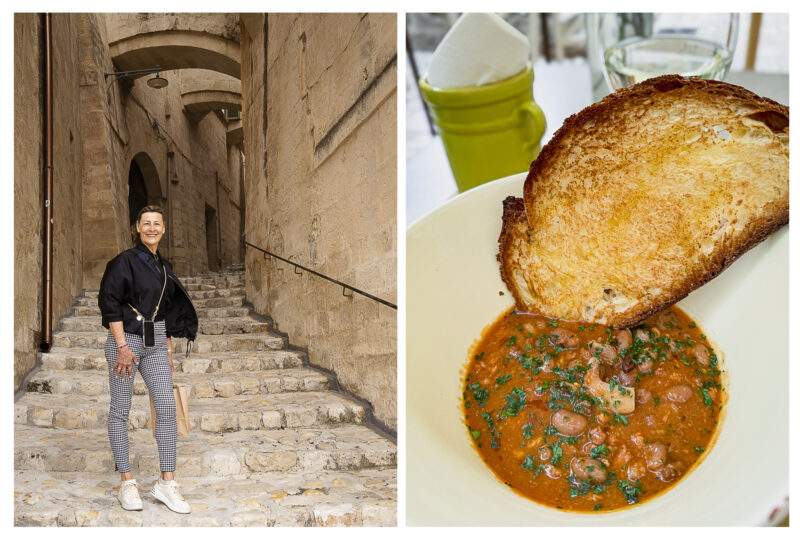The flavours of Matera: bread, beans and peperoni cruschi
Discover the flavours of Matera: from tasty bread and crispy peperoni cruschi to dishes with a history going back centuries. A culinary journey through the Sassi, with local ingredients, recipes and restaurant tips.
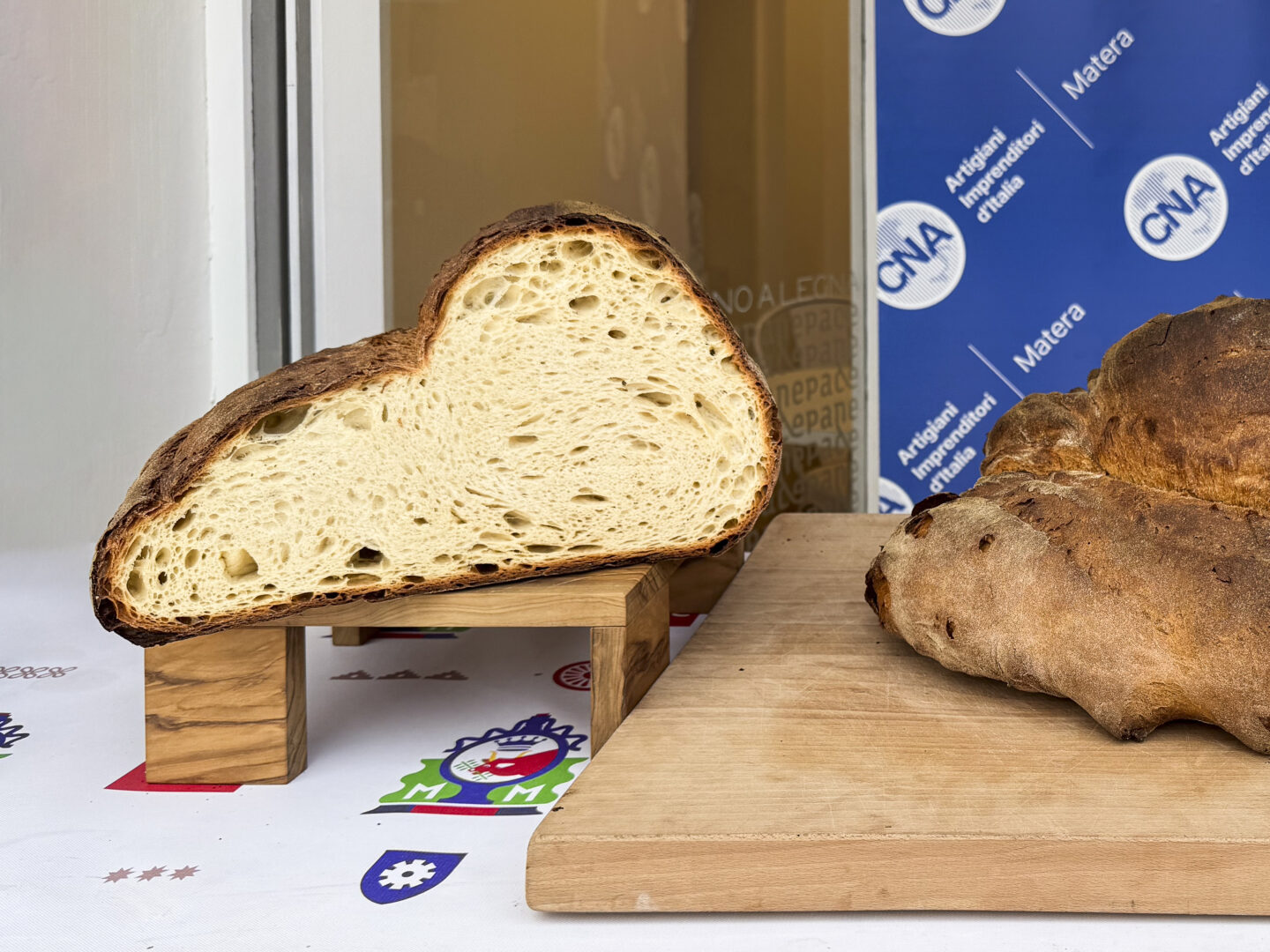
The smell of toasted bread and peperoni in the air: welcome to Matera
I wandered through the alleys of Matera for hours, enchanted by the rock churches and panoramic views, getting lost in the labyrinth of the Sassi. But what touched me as much as the landscape was the food – simple and honest, rooted in tradition.
Matera's cuisine is all about cucina povera – nutritious dishes prepared with local ingredients. Picture things like durum wheat, beans, wild herbs and lamb. And let's not forget Matera's famous bread, with its unique shape and rich flavour, which stays fresh for a week and used to be marked with personal bread stamps.
In this blog, I'll show you the best of what Matera's got to offer in the kitchen: from peperoni cruschi to broad beans, from local classics to my experiences in some of the tastiest restaurants in the city.
Matera bread – a destinctive crust and crumb
Pane di Matera is a traditional product that has played a central role in the daily life of the inhabitants for centuries. You can tell it's Pane di Matera by its recognisable shape, aroma and flavour. Since 2008, the bread has had an IGP label, which proves where it comes from and how it's made.
Durum wheat and local grains
Matera used to be the breadbasket of southern Italy. The quality of the grain from this region was so high that, according to 17th-century sources, it could be stored for up to fifteen years. The bread is still made with 100% durum wheat today, including local, ancient grains such as Senatore Cappelli. This grain is loved for its rich flavour, low gluten content and easy digestibility. Genetically modified varieties aren't allowed, so the grain still lives as it did in the past.
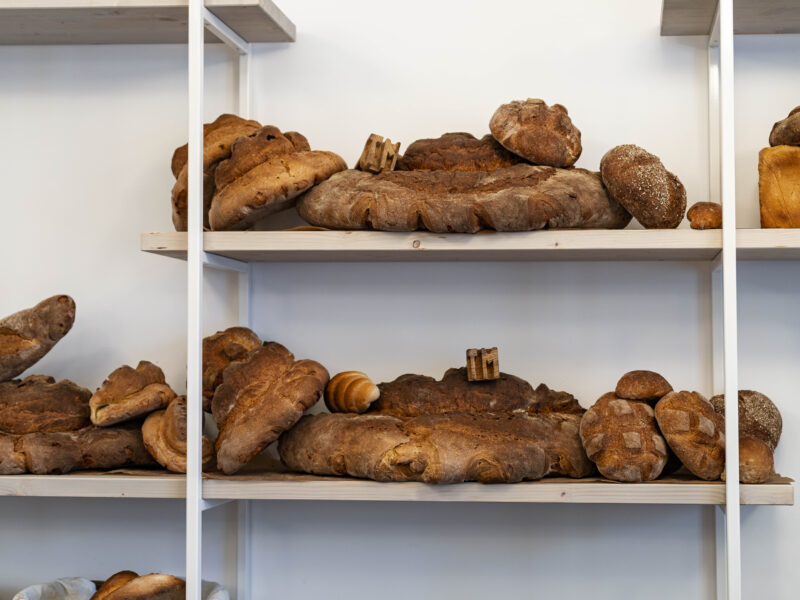
The traditional way of making bread in Matera
Matera bread starts with a sourdough starter, a living ingredient that's been passed down from generation to generation – from mother to daughter. The leaven was kept in a glazed terracotta bowl, which was a symbol of fertility. Baking bread was a ritual, and only women who mastered the craft were allowed to get married.
The dough was kneaded with a closed fist, a technique that required strength and focus. Only the woman of the house and her eldest daughter were allowed to touch the bread trough – except during their menstruation. The dough was divided into three big loaves and one smaller one, and then collected by the oven assistant to be baked in one of the communal ovens – the Sassi had fifteen of them, carved out of tuff stone. Three hours later, the bread returned home, warm and fragrant.
The characteristics of Matera bread
So, what makes this bread so special? The crust is crispy, the crumb is soft and yellow, with a specific grain size, and there's a really earthy aroma. It is robust, nutritious and elegant at the same time – basically, a bread with character.
Different shapes for different occasions
People shaped bread according to its function. They came in all sorts of shapes, from long and round to braided and crescent-shaped, and each shape had its own meaning. The most common was a tall cone shape in two tiers, perfect for farmers who needed to store their bread for up to two weeks. The ficc'latidd, a circular loaf, was traditionally baked on the 8th of December to honour the Immaculate Conception. There were also special shapes for weddings and holidays.
How the bread stayed fresh for a week
Thanks to the durum wheat and traditional preparation methods, the bread stayed fresh for a long time. But it had to be able to breathe, so it was not wrapped in plastic, but in linen or cotton and stored in a cool, dry place. This kept the crumb soft and the crust crispy – for days.
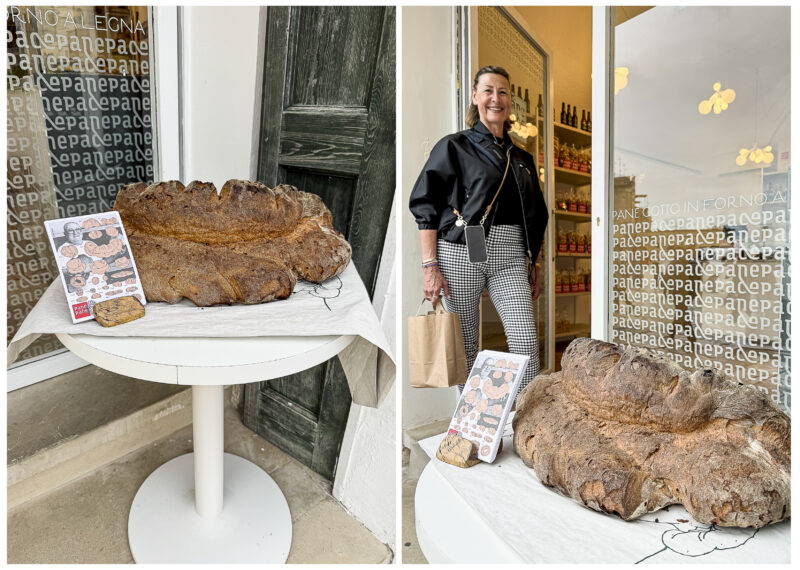
Bread stamps: function, shape and symbolism
Bread stamps were used to identify their loaves in the communal ovens. The initials of the head of the family were stamped on the bottom, with decorative figures on top: a rooster to ward off the evil eye, a dog for protection, male symbols of virility, and signs of fertility and abundance.
People often ordered the stamps from shepherds. As they moved their flocks around and were away from home, they had plenty of time to spare, and wood at their fingertips. So, they carved these little pieces of art. They were usually made of wood, sometimes terracotta, but iron ones were rare. Now, these stamps are collector's items – a tangible reminder of a time when bread was central to life.
Fun fact: a young suitor would give his beloved a bread stamp as a marriage proposal. If she accepted the stamp, it was a yes. If the engagement was broken off, the stamp was broken as well.
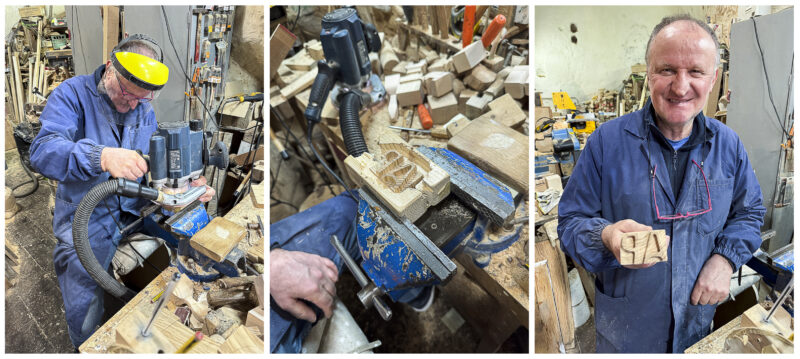
Pane e Pace
At Pane e Pace in Matera, they're keeping the tradition alive. This artisan bakery combines centuries-old techniques with modern precision. Here, you can taste the past in every bite. The smell of fresh bread, the texture of the crumb, the shape – everything about it is authentic.
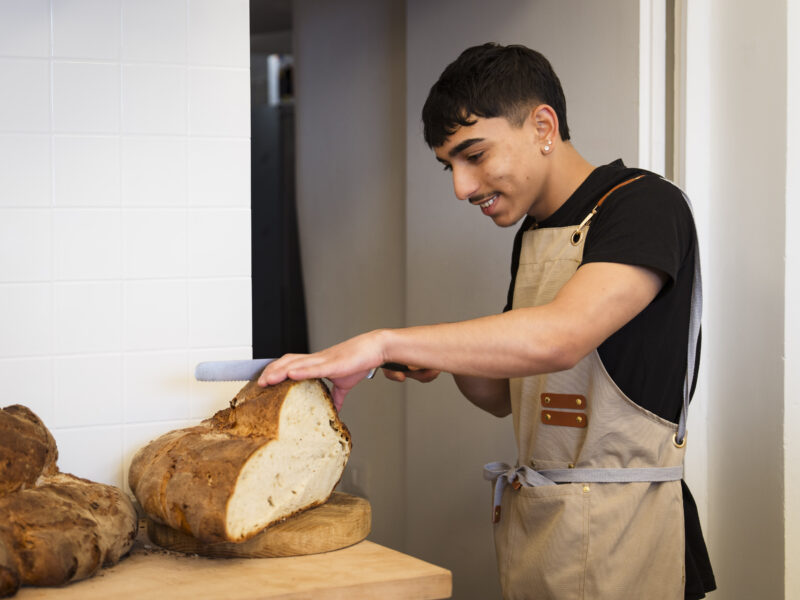
Peperoni cruschi – crispy, powerful and full of character
I discovered peperoni cruschi on a sunny afternoon on the terrace of Conzato, in the Sasso Barisano. At the table next to me, a couple ordered a bowl of shiny, deep red peppers. I heard them crunch before I saw them – and knew right away: I want to taste this too. My search took me to Eatera, a grocery shop in the Sasso Caveoso, where I bought a bag of this local delicacy.
What are peperoni cruschi?
Peperoni cruschi are sweet red peppers from Basilicata. They're dried in the sun after being harvested and then briefly fried in olive oil. The result? Crispy, intense and surprisingly mild in flavour. The word cruschi literally means 'crispy' in the local dialect.
How are they dried and fried?
After harvesting, the peppers are strung on a rope and hung out to dry in long garlands on balconies and facades. There, they'll slowly dry in the sun and wind. When they are completely dry, they are briefly fried and then salted to retain their crispy texture. You can also buy the peperoni dried and fry them yourself.
Eatera's tip: fry them in hot oil for one minute, then chill them in the fridge for five minutes. Just add a bit of salt and keep the rest in a sealed jar in a cool place.
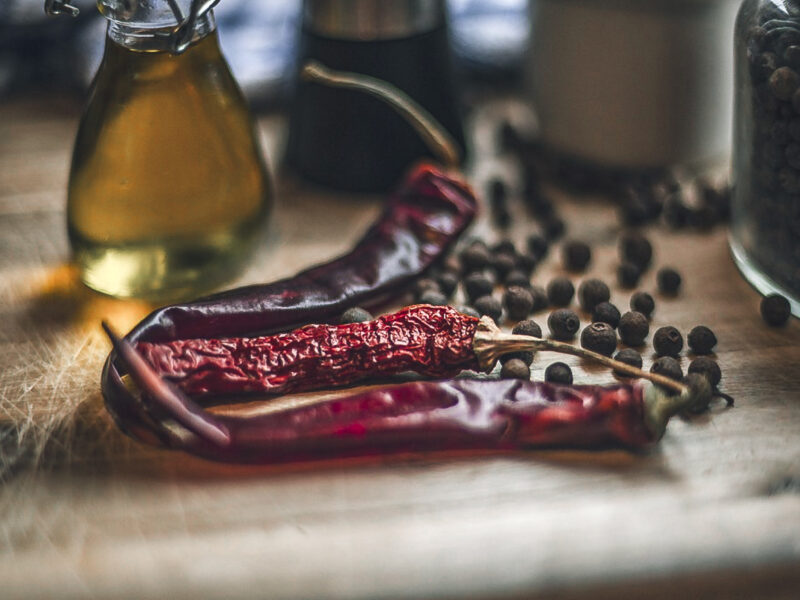
Use in the kitchen
Peperoni cruschi are versatile:
- As a snack: plain, with a little salt
- As a topping: over pasta, polenta, risotto or mashed potatoes
- As a seasoning: crumbled into stews or salads
- Combined with eggs, beans or bread: for a typical Lucanian lunch
- Peperoni cruschi pesto: with cream and pasta or like a pesto on crostini
A classic with cruschi
A classic dish is uova e peperoni cruschi – scrambled eggs with crumbled peppers, served with a piece of bread from Matera. It’s simple, nutritious and full of flavour.
Broad beans – nutritious and versatile
Broad beans are a big deal in Matera's cuisine. These pale legumes are full of protein and fibre, and they've been a reliable source of nutrition for generations. You can process them into creamy purée, stew them with aromatic herbs or serve them in hearty soups.
Historical role in cucina povera
Broad beans were a central part of Matera's cucina povera, or 'poor man's cuisine'. They were cheap, long-lasting and nutritious, which made them ideal for farming families and the inhabitants of the Sassi, who lived off what the land provided. Braised with onion and a dash of olive oil, or puréed and served with wild chicory, they were the perfect comfort food. Even now, they're still a proud ingredient in Matera's modern cuisine.
Combinations with wild herbs and olive oil
A local favourite is fave e cicorie: a silky-smooth bean purée served with bitter wild chicory. A drizzle of local olive oil, a pinch of salt, and sometimes a topping of crispy peperoni cruschi complete the dish. But broad beans can also be surprisingly sophisticated. At the restaurant Myricae, tucked away in a quiet street in Matera, I tasted them fresh in a green minestrone – together with young peas, green beans and a salty oyster. The sauce was made from the pods of the peas and fava beans themselves. The result? Fresh, green, intense.
My favourite places to eat in Matera
During my stay in Matera, I found some great restaurants and cafés. All of these places have their own vibe and way of doing things, but they're all about top-notch service, excellent quality and local ingredients. From fancy dishes to hearty favourites, here are my four top picks for places I'd happily go back to.
Ristorante Basquiat
An eclectic restaurant that pays as much homage to Jean-Michel Basquiat as it does to local cuisine. Reproductions of his most famous works are all over the place, creating a lively, creative atmosphere. The food is modern and playful, but always with respect for the ingredients.
We tried the Black Angus carpaccio, served with a sprig of smoked rosemary to rub over the meat yourself – it smelt delicious. With it came local burrata, puntarelle, orange, raspberry purée and olive oil. All of this was accompanied by warm focaccia, also perfumed with rosemary. The red tuna with tomato, olive and capers was cooked to perfection, and the roasted vegetables with basil and mint were surprisingly sophisticated. t's a place where you just want to stay a bit longer – whether it’s for the food, the atmosphere or the smiles of the staff.

Di Bitonte
Just outside the historic centre, you'll find this stylish café luxury shop, perfect for coffee, patisserie and a good aperitif. Di Bitonte is elegant without being stuffy, and perfect for a break while you’re exploring the city. Imagine yourself enjoying an espresso with a small pastry on the terrace, or a glass of sparkling wine at sunset. Here you can experience the modern side of Matera without losing the charm of the old.
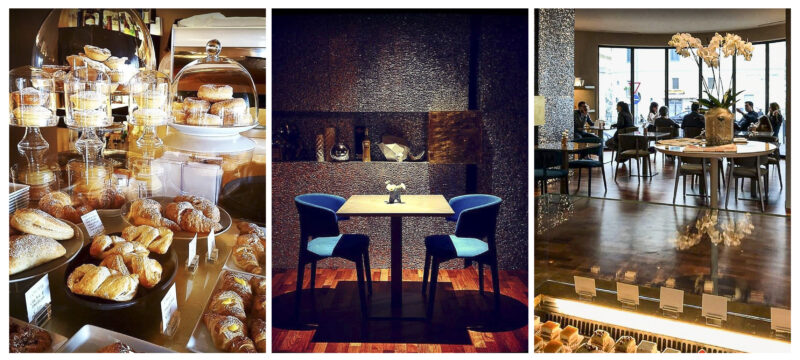
Myricae
Myricae is a restaurant that operates according to the principles of slow food, with a focus on seasonal ingredients and top-quality local products. It's tucked away in a small square near the busy Via del Corso. The cuisine is sophisticated, innovative and firmly anchored in the region, but also experiments with oriental spices and modern techniques.
We went for the tasting menu and tried a fresh green minestrone with oyster, where the broth was extracted from pea pods and broad beans – this made the flavour even better. The hamachi tartare with fennel, stracciatella cream and parsley oil was delicate and perfectly balanced. Then there was the fresh pasta with octopus, olives and katsuobushi – a heavenly dish. The flavours were rich and full of umami, but also refreshing, with a surprising touch of fennel oil. The ravioli with pork cheek and neck, finished with a butter sauce, basil oil and a cloud of caciocavallo cream, was absolutely amazing. Myricae is a place where every detail matters – from the ingredients to the vibe around the open kitchen.

Cozato
For a more home-style experience, I had lunch on the terrace of Cozato, where I ate zuppa lucana: a thick, hearty soup made with cannellini beans, bacon, tomato and mushrooms. Served with a thick slice of toasted Matera bread, drizzled with local olive oil. It’s simple, honest and warming – just what you want after a morning wandering through the city's alleys.
